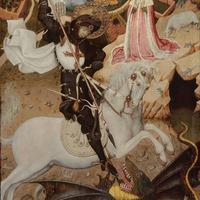More about Bernat Martorell
Works by Bernat Martorell

Sr. Contributor
Bernat Martorell was the most prominent artist of the International Gothic style in Barcelona, Catalonia (a disputed, autonomous region of modern-day Spain), but much of his life is shrouded in mystery.
There is no record of him before 1427, but he was probably born in Sant Celoni, Catalonia around 1400. It is unclear where, how, or by whom he received his education, but his works show levels of narrative and compositional complexity unknown in Catalan art up to that time; it was more akin to blooming Northern Renaissance artists like Jan van Eyck. Martorell is distinct in this respect from earlier Catalan artists such as Luís Borrassá, who may have been his teacher and whose fame Martorell eclipsed. Like many artists of the period, Martorell worked in a variety of formats including miniatures, illuminating manuscripts, carving sculptures, designing stained glass, and textile embroidery, but he is primarily known for his elaborate altarpieces.
Though religious in theme, his work shows a strong sense of spectacle, drama and violence. The late-medieval Catholic preoccupation with martyrdom offered plenty of opportunities to paint what essentially amounts to ye olde “torture porn,” depictions of the horrifically gruesome persecution and deaths of saints in graphic detail. Some of Martorell’s most notable of these are also distinctly female-centric, featuring the martyrdom of Saint Eulalia, Saint Lucy, and Saint Catherine, three badass women/girls who were murdered for being too outspoken and resisting patriarchal marriage.
Perhaps unsurprisingly for an artist who was scarcely even identified by name until the 20th Century, almost nothing appears about Martorell’s personal life. There’s at least one reference to him having married twice and fathered children, but the source is spotty. He died in Barcelona in 1452. Martorell was a profound influence on the next generation of Catalan painters, especially Jaume Huguet.
Sources
- TheBiography. “Biography of Bernat Martorell.” Accessed July 28, 2020. https://thebiography.us/en/martorell-bernat
- Cornudella, Rafael, César Favá, and Guadaira Macías. Gothic Art in the MNAC collections. Translated by Andrew Langdon-Davies. Barcelona: Museu Nacional d’Art de Catalunya, 2011.
- Google Arts & Culture. “Bernat Martorell.” Accessed July 28, 2020. https://artsandculture.google.com/entity/bernat-martorell/m0cnz9j?hl=en
- History of Art. “Gothic Art: Bernat Martorell.” Accessed July 28, 2020. http://www.all-art.org/gothic_era/14.html
- Museu Nacional d’Art de Catalunya. “Bernat Martorell.” Search the Collection. Accessed July 28, 2020. https://www.museunacional.cat/ca/advanced-piece-search/15424
- Web Gallery of Art. “Martorell, Bernat: Biography.” Accessed July 28, 2020. https://www.wga.hu/frames-e.html?/bio/m/martorel/biograph.html
Featured Content
Here is what Wikipedia says about Bernat Martorell

Bernat Martorell (died 1452 in Barcelona) was the leading painter of Barcelona, in modern-day Spain. He is considered to be the most important artist of the International Gothic style in Catalonia. Martorell painted retable panels and manuscript illuminations, and carved sculptures and also provided designs for embroideries.
Biography

Little is known of his life prior to 1427, though by the mid-15th century he was one of the leading artists in Catalonia. The style of Martorell is contrastingly different from the Catalan Gothic painters who preceded him chronologically, including Lluís Borrassà. It shows that Martorell was familiar with contemporary Flemish painting, however, the documented part of his biography does not explain this influence. On the other hand, stylistic parallels have been drawn between Martorell and contemporary Italian artists, including Pisanello, Sassetta, and Gentile da Fabriano, but without any documentary evidence.
Sometimes the Retable of Saint John the Baptist from Cabrera de Mar (Museu Diocesà de Barcelona) is attributed to Martorell. If he indeed painted the retable, this could explain the gap between Martorell and the International Gothic in Catalunya. There is, however, no documented evidence that Martorell painted the retable, and his authorship has been disputed.
One of the earliest surviving works of Martorell, Saint George Killing the Dragon (tempera on panel, Art Institute of Chicago), depicting Bernat Martorell's patron saint, was created in the early 1430s and already demonstrates the complexity of composition, richness of colors and fine details which could only have been executed by a fully trained artist. These details were not present in Catalan art before Martorell.
About the same time, Martorell also executed illustrations to the Ferial Psalter and the Book of Hours, and painted the Predella of the Passion of Christ (Museu de la Catedral de Barcelona). Two altarpieces, Retable of Saint Vincent (which survived entirely) and Retable of Saint Lucy (the top of the central section was probably executed by another painter) were apparently painted in the 1430s.
In 1437, Bernat Martorell got a commission to create an altarpiece (Retable of Saint Pere de Púbol) for the church in Púbol. The altarpiece devoted to Saint Peter, is currently in Museu d'Art de Girona and is the only directly documented piece produced by the artist. The retable was completed in the beginning of the 1440s. Very similar style is found in the Retable of Saint John, which was kept in the parish church of Vinaixa, as well as in the Retable of Saint Michael from La Pobla de Cérvoles. This style shows more attention to detail than earlier works by Martorell.
Between 1445 and 1452, Bernat Martorell produced the Retable of the Transfiguration from the Barcelona Cathedral and the Main Retable of Santa Maria del Mar in the cathedral of Santa Maria del Mar.
It is also presumed that Martorell provided a model according to which the embroiderer Antonio Sadurní executed the altar frontal of Saint George, between 1450 and 1451, conserved in the Palau de la Generalitat de Catalunya's Capella de Sant Jordi.
Check out the full Wikipedia article about Bernat Martorell











